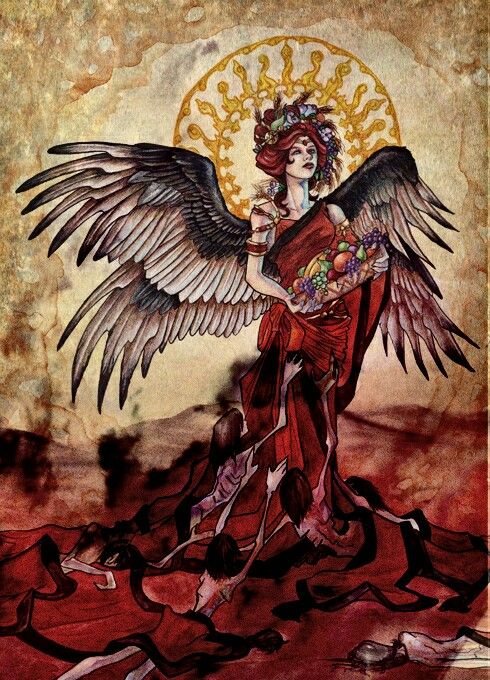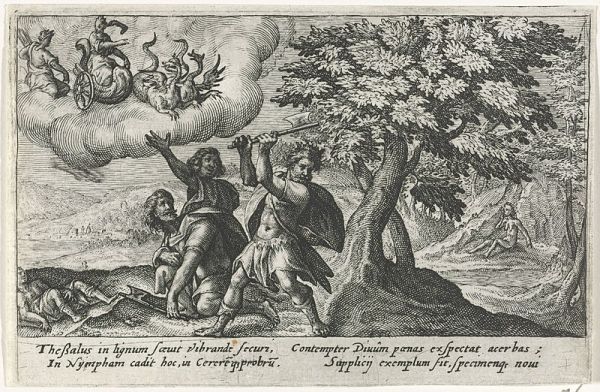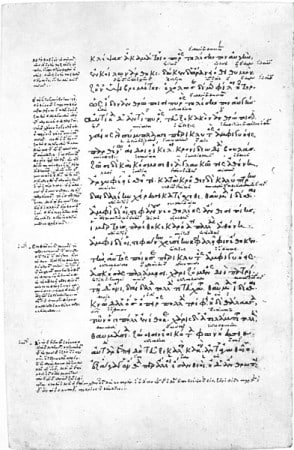Limos, the Greek deity of starvation, is a lesser-known figure in Greek mythology but plays an important role in the pantheon of gods and goddesses. The deity, which was commonly associated with hunger, famine, and starvation, played an important role in the lives of both mortals and immortals. Let us delve deeper into Limos’ otherworldly story, which includes other Underworld deities.
Limos Key Facts
| Parents | Eris (Discord) |
| Partners | None |
| Siblings | Algos, Amphillogiai, Androktasiai, Atë, Dysnomia, Horkos, Hysminai, Lethe, Logoi, Machai, Neikea, Phonoi, Ponos, Pseudea |
| Offspring | None |
| Other names | None |
| Greek name | Λιμός |
| Roman name | Fames |
| Best Known Myths | Sentinel of Hades, Erysichthon’s punishment |
Name and Etymology

The name Limos comes from the Greek word λιμός which literally means hunger, starvation. The name of the deity is identical to the word for hunger, reflecting the deity’s role in causing famine and starvation. In Roman mythology, Limos in known as Fames, which has a direct connection to the word for famine.
Limos was known under no other names in Greek or Roman mythology.
Limos Family and Relationships
Limos is the daughter of Eris, the goddess of discord, as revealed by Hesiod’s Theogony, emphasizing her association with strife and suffering. Eris (or Discordia in Roman mythology) is the goddess of discord, as her name implies.
The deity had numerous siblings, including:
- Algos (Pain)
- Amphillogiai (Disputes)
- Androktasiai (Manslaughters)
- Atë (Ruin)
- Dysnomia (Lawfulness)
- Horkos (Oath)
- Hysminai (Battles)
- Lethe (Forgetfulness)
- Logoi (Stories)
- Machai (Wars)
- Neikea (Quarrels)
- Phonoi (Murders)
- Ponos (Hardship)
- Pseudea (Lies)
Limos, the deity of starvation, was widely feared and avoided by both mortals and immortals. As a result, he or she has no other relationships besides those with their family. However, the deity was occasionally invoked by those seeking vengeance or retribution.
Myths about Limos
He/she is a lesser-known deity, so there aren’t many myths featuring him/her. Let’s look at some of the most common ones from Greek and Roman mythology.
The Children of Eris
Because the Greek religion was not fully unified, there are various accounts of who Eris was and her exact relationship with Limos. According to Hesiod’s Theogony, Eris was either Nyx’s daughter or the daughter of Nyx and Erebus, the god of darkness. Eris (Discord) had five siblings: Apate (Deceit), Geras (Old age), Momos (Blame), Nemesis (Envy), and Oizys (Misery).
There are differing opinions on whether Eris was the mother of Limos and her siblings, or if they are a “part” of Eris. According to most accounts, Eris spawned a collection of malevolent daemons or cacodaemons, including Limos, the deity of starvation and strife.
Eris’ other children include Algos (Pain), Amphillogiai (Disputes), Androktasiai (Manslaughters), Atë (Ruin), Dysnomia (Lawfulness), Horkos (Oath), Hysminai (Battles), Lethe (Forgetfulness), Logoi (Stories), Machai (Wars), Neikea (Quarrels), Phonoi (Murders), Ponos (Hardship), and Pseudea (Lies).
Sentinel of Hades
Limos, according to both Virgil and Seneca, was one of the spirits who guarded the entrance to the Underworld, serving as a true sentinel for Hades.
In Virgil’s Aeneid, Sibyl guides the hero, Aeneas, through Hades. In the first entrances to the Underworld, Aeneas encounters Curae (Cares) and Penthus (Sorrow) lying on couches. Then he finds Limos, along with Geras, Nosos (Disease), and Deimos (Fear). After encountering more daemons and evil spirits, he finally sees Erinyes (the Furies) and Eris herself.
In Hercules Furens, Seneca, on the other hand, describes the area surrounding Cocytus, the river of lamentation in Hades. Seneca describes Cocytus as a filthy swamp where owls and vultures lie and screech. Limos is one of many spirits and demons, including Hypnos, Geras, War, and others. Limos is depicted as a sad deity who lies by Cocytus with “wasted jaws.”
In all accounts, the deity, along with Eris’ other children and cacodaemons, guard or wander around Hades’ entrance.
The Punishment of Erysichthon
Limos figures prominently in only one known myth: King Erysichthon’s punishment. Limos, according to Ovid’s Metamorphoses, lives in a freezing and barren place at the far end of Scythia with Frigus (Cold), Pallor (paleness), and Tremor (Ague).
One day, King Erysichthon of Thessaly ordered that all of the trees in a sacred grove of Demeter be cut down. There was a massive oak in the center of the grove, adorned with votive wreaths. That tree represented every prayer to Demeter, which she had granted. Erysichthon’s men refused to cut it down, so the king grabbed an axe and did it himself. He also killed a dryad nymph, who cursed him while she was dying.

Demeter heard the nymph’s curse and decided to respond. She considered entreating her counterpart, Limos. However, because Demeter and Limos are polar opposites, they can never meet in person. Demeter asked an Oread, a mountain nymph, to go speak with her (a goddess in this story) and request that she inflict eternal hunger on Erysichthon.
Limos agrees and visits Erysichthon at midnight. She crawls towards him in this chamber, wraps him in her arms, and, according to Ovid, “breathes emptiness” into him. Erysichthon has an unquenchable appetite. No matter how much he eats, he becomes increasingly hungry and is unable to satisfy it. Erysichthon eventually resorts to eating his own flesh to put an end to his agony.
Depiction And Characteristics
The deity is frequently depicted as a grim figure with sunken cheeks and hollow eyes, representing the agony that hunger causes. It is interesting to note that Limos, unlike most gods and goddesses in the Greek pantheon, is of indeterminate sex. The deity is portrayed as a male or female deity depending on the cult, time period, and region.
According to Ovid’s Metamorphosis, Limos had coarse hair, a shallow face with sunken eyes and crusted white lips, and a throat scaly with scurf. Her organs could be seen through her skin, and her body was clearly old, with only a void where her stomach should have been.
Limos, the daemon of famine and hunger, is associated with strife and discord. He/she has an emaciated appearance and a grim, forbidding demeanor, representing starvation and scarcity. While Limos had a haunting and dreadful presence, he was feared and avoided, but was occasionally summoned by those seeking vengeance or retribution, such as Erysichthon.
The deity was the exact opposite of Demeter, the goddess of harvest and agriculture. Plutus, the personification and god of wealth and abundance, also opposed her.
Representations in Art
While there are no specific paintings or sculptures dedicated to Limos in ancient art, we can imagine her representation based on her role as the goddess of famine. She could be portrayed in our minds as having a haunting presence, emaciated features, and a grim demeanor, symbolizing the constant hunger and suffering she causes. The lack of direct artistic representations allows the imagination to create a powerful and evocative image of Limos as a deity of scarcity and starvation, representing the consequences of greed and arrogance.
Mentions of Limos in Ancient Texts
Hesiod’s Theogony

Limos is mentioned as the offspring of Eris in Hesiod’s epic work, Theogony, which was written in the 8th or 7th century B.C., along with other deities representing pain, battles, murder, and quarrels. The deity represents starvation, a concept that causes suffering and strife and belongs in the pantheon of malevolent beings in Greek mythology.
Ovid’s Metamorphoses
Ovid’s Roman epic Metamorphoses, penned in the 1st century B.C. to the 1st century A.D., depicts Limos as a punishment inflicted by Demeter upon the impious King Erysichthon. Fames, or Hunger, is depicted as an unstoppable force that causes insatiable cravings and suffering. The vivid description creates a haunting image of Limos’ appearance and the consequences of her presence.
Virgil’s Aeneid
Limos appears in the Underworld alongside other malevolent beings such as Grief, Fear, and Death, according to Virgil’s Aeneid, a Roman epic from the first century B.C. Limos is portrayed as a sinful temptress who represents the consequences of want and starvation. Her presence is depicted in an eerie way, adding to the Underworld’s dark atmosphere.
Seneca’s Hercules Furens
Limos is described in Seneca’s first-century A.D. tragedy Hercules Furens as lying with wasted jaws in the Underworld alongside other grim figures such as Shame, Fear, and Disease. Limos’ portrayal emphasizes her association with suffering and need, contributing to the scene’s somber tone.
Frequently Asked Questions
Limos is indeed described as a daughter of Eris, the goddess of strife, in Greek mythology. Alongside her, Eris bore other malevolent deities such as Machai, Ponos, Lethe, Dysnomia, Ate, and others.
The deity was depicted as either a male or a female deity in Greek and Roman mythology, depending on the source, cult, place of worship, or time period.
Limos is said to inflict constant hunger and insatiable cravings on people as a form of punishment or consequence for their actions, emphasizing the devastating effects of famine and scarcity.
Limos’ association with other malevolent deities, such as Strife and Grief, reflects her role in causing suffering and strife throughout the world. Together, they represent various aspects of pain and hardship.
Featured Image Credit: Pinterest
